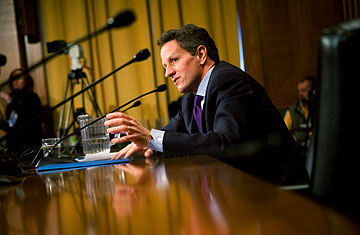
Timothy Geithner, President Barack Obama's nominee for Treasury Secretary, testifies at his confirmation hearing before the Senate Committee on Finance on Jan. 21, 2009
(2 of 2)
But beyond tougher rhetoric, is the new Administration really likely to get tough with China on trade, as so many union supporters of Obama hope? Unlikely. In fact, it's hard to think of anything business and investors on both sides of the Pacific would welcome less right now than a U.S.-China trade rumble. Both countries are in the midst of serious economic pain, which trade tensions would only worsen. There are enough comparisons with the Great Depression out there already without dredging up the memory of Smoot-Hawley, the 1930 legislation in the U.S. that put a tariff on some 20,000 imported goods — to devastating effect on trade.
Geithner, despite the rhetoric before the Senate, understands this better than most. He spent much of his career in the 1990s at the Treasury Department working on international issues, with particular emphasis on Asia. He understands how complex the bilateral economic relationship with China is and will probably be inclined to resist pressure to formally cite Beijing as a bad actor on currency. (See pictures of the global financial crisis.)
That reluctance is not necessarily for the reason often cited when U.S.-China trade issues come up. A frequent assertion by critics of U.S. trade policy is that Washington can't afford to get tough with China on trade because Beijing buys so much U.S. Treasury debt. Washington can't even say "Boo" to the Chinese, this argument goes, without risking that China would take its money and go home, driving U.S. interest rates up in the process.
This is a fundamental misreading of the U.S.-China economic relationship. The Chinese RMB would go up in value relative to the dollar (exactly what some critics seek) if the Chinese did repatriate more of the money they earn via exports instead of reinvesting those dollars back into Treasuries. But the Chinese, despite some scary stories that have circulated to the contrary, show absolutely no sign of doing that. In November, the last month for which data is available, Beijing actually added $29 billion to its overall position in U.S. debt. (Beijing sold $9.2 billion of long-term U.S. Treasuries in November but bought $38.2 billion of short-term government notes.) Indeed, part of the reason short-term interest rates are so low in the U.S., as Council on Foreign Relations economist Brad Setser notes, is that foreign central banks — including China's — are doing the same thing private investors have been doing: pouring funds into short-term, highly liquid, dollar-based assets. If China reversed course and pulled money out of the U.S. in a big way, it would ravage the value of its own portfolio, which is still largely invested in long-term bonds and notes. This is the essence of mutually assured economic destruction, and the Chinese understand that as well as anyone.
Perhaps it's true that if sufficiently angered by U.S. trade policy, China would feel compelled to inflict economic pain on itself by dumping U.S. debt, in order to send a message to Washington. But Geithner, despite his brief rhetorical flourish about manipulation, knows what his job is when it comes to persuading foreigners (whether governments or individuals) to continue to invest in Treasuries. Sources close to the Administration say that thus far he has argued privately that "what the world wants to know, first, is that we are going to fix this [economic and financial] problem and make people confident in the quality of the stewardship of the economy." The world also wants to know, one source close to Geithner says, "that we are going to make sure the U.S. will grow over time and that we will continue to be open to the world for trade and investment."
A trade conflict with China, Geithner knows, doesn't fit anywhere in that prescription.
